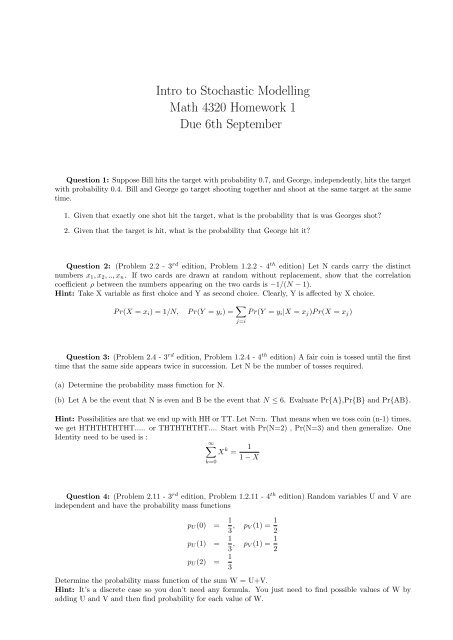Intro to Stochastic Modelling Math 4320 Homework 1 Due 6th ...
Intro to Stochastic Modelling Math 4320 Homework 1 Due 6th ...
Intro to Stochastic Modelling Math 4320 Homework 1 Due 6th ...
Create successful ePaper yourself
Turn your PDF publications into a flip-book with our unique Google optimized e-Paper software.
<strong>Intro</strong> <strong>to</strong> S<strong>to</strong>chastic <strong>Modelling</strong><br />
<strong>Math</strong> <strong>4320</strong> <strong>Homework</strong> 1<br />
<strong>Due</strong> <strong>6th</strong> September<br />
Question 1: Suppose Bill hits the target with probability 0.7, and George, independently, hits the target<br />
with probability 0.4. Bill and George go target shooting <strong>to</strong>gether and shoot at the same target at the same<br />
time.<br />
1. Given that exactly one shot hit the target, what is the probability that is was Georges shot?<br />
2. Given that the target is hit, what is the probability that George hit it?<br />
Question 2: (Problem 2.2 - 3rd edition, Problem 1.2.2 - 4th edition) Let N cards carry the distinct<br />
numbers x1, x2, .., xn. If two cards are drawn at random without replacement, show that the correlation<br />
coefficient ρ between the numbers appearing on the two cards is −1/(N − 1).<br />
Hint: Take X variable as first choice and Y as second choice. Clearly, Y is affected by X choice.<br />
P r(X = xi) = 1/N, P r(Y = yi) = ∑<br />
P r(Y = yi|X = xj)P r(X = xj)<br />
Question 3: (Problem 2.4 - 3 rd edition, Problem 1.2.4 - 4 th edition) A fair coin is <strong>to</strong>ssed until the first<br />
time that the same side appears twice in succession. Let N be the number of <strong>to</strong>sses required.<br />
(a) Determine the probability mass function for N.<br />
(b) Let A be the event that N is even and B be the event that N ≤ 6. Evaluate Pr{A},Pr{B} and Pr{AB}.<br />
Hint: Possibilities are that we end up with HH or TT. Let N=n. That means when we <strong>to</strong>ss coin (n-1) times,<br />
we get HTHTHTHTHT..... or THTHTHTHT.... Start with Pr(N=2) , Pr(N=3) and then generalize. One<br />
Identity need <strong>to</strong> be used is :<br />
∞∑<br />
X k = 1<br />
1 − X<br />
k=0<br />
Question 4: (Problem 2.11 - 3 rd edition, Problem 1.2.11 - 4 th edition) Random variables U and V are<br />
independent and have the probability mass functions<br />
j=i<br />
pU(0) = 1<br />
3 , pV (1) = 1<br />
2<br />
pU(1) = 1<br />
3 , pV (1) = 1<br />
2<br />
pU(2) = 1<br />
3<br />
Determine the probability mass function of the sum W = U+V.<br />
Hint: It’s a discrete case so you don’t need any formula. You just need <strong>to</strong> find possible values of W by<br />
adding U and V and then find probability for each value of W.
Question 5: (Problem 3.4 - 3 rd edition, Problem 1.3.4 - 4 th edition) Let U be a Poisson random variable<br />
with mean µ. Determine the expected value of the random variable V=1/(1+U).<br />
Hint: No need <strong>to</strong> find density of V. It’s same as <strong>to</strong> find E(g(U))<br />
Question 6: (Problem 3.7 - 3 rd edition, Problem 1.3.7 - 4 th edition) Let X and Y be independent random<br />
variables having means µ and ν, respectively. Evaluate the convolution of their mass functions <strong>to</strong> determine<br />
the probability distribution of their sum Z=X+Y.<br />
Question 7: (Problem 3.12 - 3 rd edition, Problem 1.3.12 - 4 th edition) Suppose that the telephone calls<br />
coming in<strong>to</strong> a certain switchboard during a one-minute time interval follow a Poisson distribution with mean<br />
λ = 4. If the switchboard can handle at most 6 calls per minute, what is the probability that the switchboard<br />
will receive more calls than it can handle during a specified one-minute interval?]<br />
Question 8: (Exercise 4.4 - 3 rd edition, Exercise 1.4.4 - 4 th edition) Twelve independent random variables,<br />
each uniformly distributed over the interval (0,1], are added, and 6 is subtracted from the <strong>to</strong>tal.<br />
Determine the mean and variance of the resulting random variable.<br />
Question 9: (Problem 4.3 - 3 rd edition, Problem 1.4.3 - 4 th edition) Let X and Y be independent random<br />
variables uniformly distributed over the interval [θ − 1 1<br />
2 , θ + 2 ] for some fixed θ. Show that W = X - Y has a<br />
distribution that is independent of θ with density function<br />
⎧<br />
⎨ 1 + w for − 1 ≤ w < 0<br />
fW (w) =<br />
⎩<br />
1 − w<br />
0<br />
for 0 ≤ w ≤ 1<br />
for |w| > 1

















